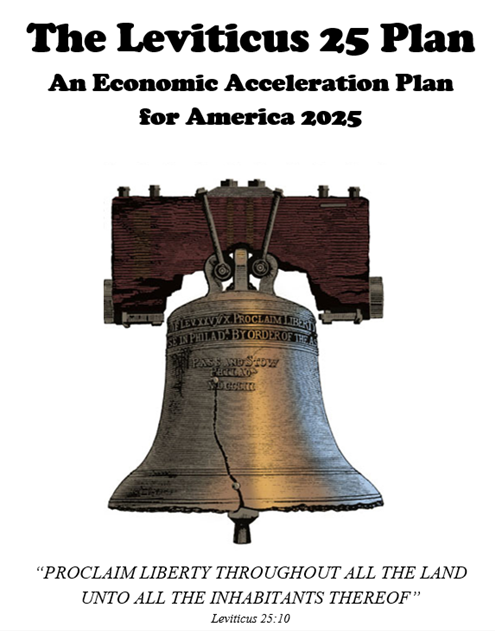The Leviticus 25 Plan – the most powerful economic acceleration plan in the world: economic scoring summary.

____________________________
Federal Income Tax Recapture
The scoring model assumes that 80% of U.S. citizens will participate in The Leviticus 25 Plan.
Participants must give up their tax refunds through the Plan’s recapture provisions for the 5-year target period (2026-2030).
According to 2024 IRS Filing season statistics, through Dec 27, 2024: 104,866,000 total refunds were paid out, totaling $329.073 billion.
Refund totals have increased by ~$25.312 billion over the past seven years, from $303.761 billion (2018) to a current (estimated) $329.073 billion (2024), representing an average increase of $3.6 billion per year.
A conservative estimated average of $3.6 billion per year (2026-2030) will be used for this recapture calculation.
2024: $329.1 billion
2025: $332.7 billion
2026: $336.3 billion
2027: $339.9 billion
2028: $343.5 billion
2029: $347.1 billion
2030: $350.7 billion
Total: $1.718 trillion
Total recapture X 80%: $1.717 trillion X .8 = $1.374 trillion
Total recapture per annum (2026-2030): $1.374 trillion / 5 = $274.8 billion
Source(s): https://www.irs.gov/newsroom/filing-season-statistics-by-year
____________________
Means-tested welfare / Economic Security Programs – Recapture
Participants in the Plan will forego Economic Security Program benefits and select means-tested welfare benefits for the period 2026-2030.
Economic security programs: About 11 percent (or $742.5 billion) of the federal budget in 2024 supported [safety net] programs that provide aid (other than health insurance or Social Security benefits) to individuals and families facing hardship. Economic security programs include: the refundable portions of the Earned Income Tax Credit and Child Tax Credit, which assist low- and moderate-income working families; programs that provide cash payments to eligible individuals or households, including unemployment insurance and Supplemental Security Income for low-income people who are elderly or disabled; various forms of in-kind assistance for low-income people, including the Supplemental Nutrition Assistance Program (formerly known as food stamps), school meals, low-income housing assistance, child care assistance, and help meeting home energy bills; and other programs such as those that aid abused or neglected children.1
Source: https://www.cbpp.org/research/federal-budget/where-do-our-federal-tax-dollars-go
The Plan assumes a modest 1.5% growth / year:
2024: $742.500 billion
2025: $742.500 billion + $11.138 billion = $753.638 billion
2026: $753.638 billion + $11.305 billion = $764.943 billion
2027: $764.943 billion + $11.474 billion = $776.417 billion
2028: $776.417 billion + $11.646 billion = $788.063 billion
2029: $788.063 billion + $11.821 billion = $799.884 billion
2030: $799.884 billion + $11.998 billion = $811.882 billion
Total projected federal means-tested welfare outlays 2026-2030 = $3.941 trillion
Assuming 80% participation: $3.941 trillion x .8 = $3.153 trillion
Total Means-tested Welfare recapture during the 5-year target period (2026-2030): $3.153 trillion
Source(s): https://www.cbpp.org/research/federal-budget/where-do-our-federal-tax-dollars-go
https://www.ssa.gov/policy/docs/statcomps/ssi_monthly/2024-11/table01.html
https://turbotax.intuit.com/tax-tips/general/how-are-federal-taxes-spent/L6kinGuUt : “Safety net programs, including unemployment insurance, food stamps, and low-income housing assistance, make up about 11% of your federal budget [$742.5 billion].”
https://fiscaldata.treasury.gov/americas-finance-guide/federal-spending/ 2024 – $6.75 trillion”
